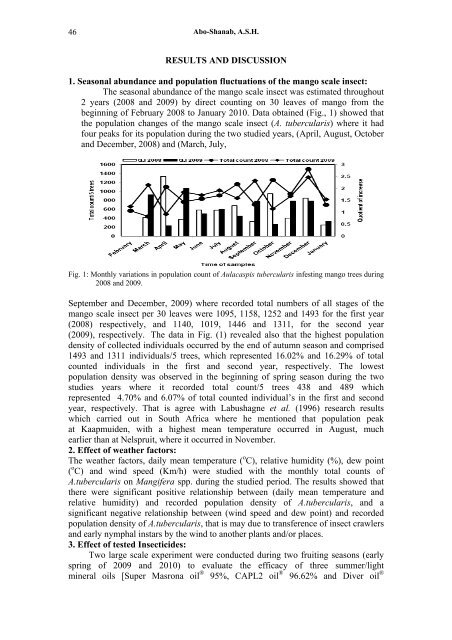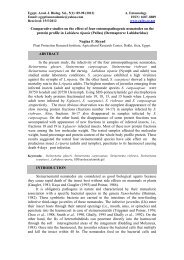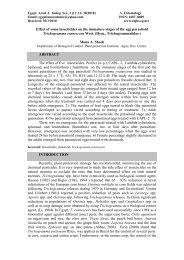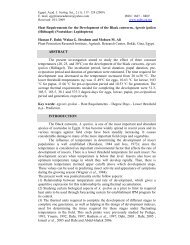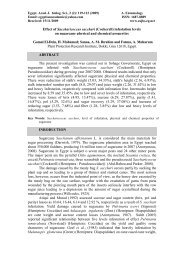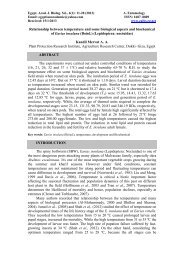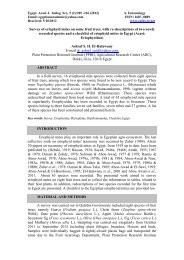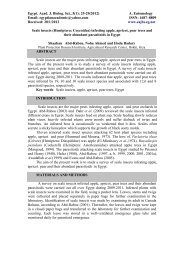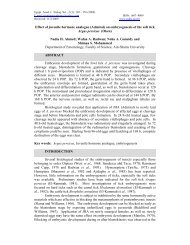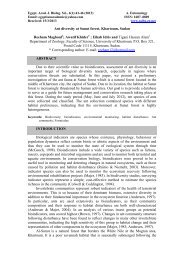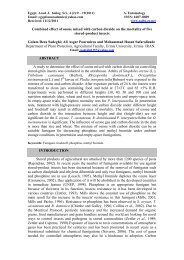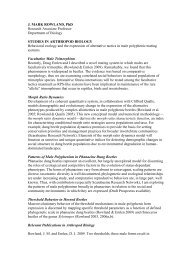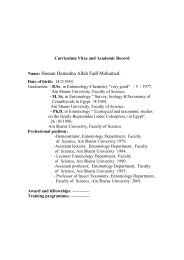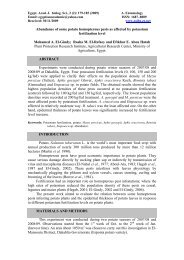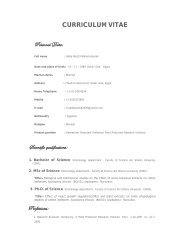Suppression of white mango scale, Aulacaspis tubercularis ...
Suppression of white mango scale, Aulacaspis tubercularis ...
Suppression of white mango scale, Aulacaspis tubercularis ...
You also want an ePaper? Increase the reach of your titles
YUMPU automatically turns print PDFs into web optimized ePapers that Google loves.
46<br />
Abo-Shanab, A.S.H.<br />
RESULTS AND DISCUSSION<br />
1. Seasonal abundance and population fluctuations <strong>of</strong> the <strong>mango</strong> <strong>scale</strong> insect:<br />
The seasonal abundance <strong>of</strong> the <strong>mango</strong> <strong>scale</strong> insect was estimated throughout<br />
2 years (2008 and 2009) by direct counting on 30 leaves <strong>of</strong> <strong>mango</strong> from the<br />
beginning <strong>of</strong> February 2008 to January 2010. Data obtained (Fig., 1) showed that<br />
the population changes <strong>of</strong> the <strong>mango</strong> <strong>scale</strong> insect (A. <strong>tubercularis</strong>) where it had<br />
four peaks for its population during the two studied years, (April, August, October<br />
and December, 2008) and (March, July,<br />
Fig. 1: Monthly variations in population count <strong>of</strong> <strong>Aulacaspis</strong> <strong>tubercularis</strong> infesting <strong>mango</strong> trees during<br />
2008 and 2009.<br />
September and December, 2009) where recorded total numbers <strong>of</strong> all stages <strong>of</strong> the<br />
<strong>mango</strong> <strong>scale</strong> insect per 30 leaves were 1095, 1158, 1252 and 1493 for the first year<br />
(2008) respectively, and 1140, 1019, 1446 and 1311, for the second year<br />
(2009), respectively. The data in Fig. (1) revealed also that the highest population<br />
density <strong>of</strong> collected individuals occurred by the end <strong>of</strong> autumn season and comprised<br />
1493 and 1311 individuals/5 trees, which represented 16.02% and 16.29% <strong>of</strong> total<br />
counted individuals in the first and second year, respectively. The lowest<br />
population density was observed in the beginning <strong>of</strong> spring season during the two<br />
studies years where it recorded total count/5 trees 438 and 489 which<br />
represented 4.70% and 6.07% <strong>of</strong> total counted individual’s in the first and second<br />
year, respectively. That is agree with Labushagne et al. (1996) research results<br />
which carried out in South Africa where he mentioned that population peak<br />
at Kaapmuiden, with a highest mean temperature occurred in August, much<br />
earlier than at Nelspruit, where it occurred in November.<br />
2. Effect <strong>of</strong> weather factors:<br />
The weather factors, daily mean temperature ( o C), relative humidity (%), dew point<br />
( o C) and wind speed (Km/h) were studied with the monthly total counts <strong>of</strong><br />
A.<strong>tubercularis</strong> on Mangifera spp. during the studied period. The results showed that<br />
there were significant positive relationship between (daily mean temperature and<br />
relative humidity) and recorded population density <strong>of</strong> A.<strong>tubercularis</strong>, and a<br />
significant negative relationship between (wind speed and dew point) and recorded<br />
population density <strong>of</strong> A.<strong>tubercularis</strong>, that is may due to transference <strong>of</strong> insect crawlers<br />
and early nymphal instars by the wind to another plants and/or places.<br />
3. Effect <strong>of</strong> tested Insecticides:<br />
Two large <strong>scale</strong> experiment were conducted during two fruiting seasons (early<br />
spring <strong>of</strong> 2009 and 2010) to evaluate the efficacy <strong>of</strong> three summer/light<br />
mineral oils [Super Masrona oil ® 95%, CAPL2 oil ® 96.62% and Diver oil ®


